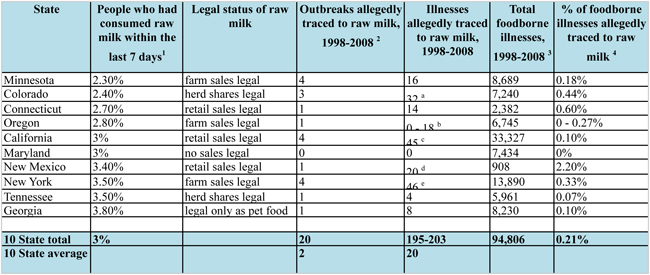Improving Legal Access to Raw Milk Will Not Increase Foodborne Illness Outbreaks
One argument that has been raised against legalizing raw milk (read about HB 46 in Texas) is that, in essence: “If you make it easier to get raw milk legally, more people will drink raw milk, and more people will get sick.” While that argument is intuitively appealing, it is contradicted by the CDC’s data.
The chart below shows the consumption of raw milk in 10 states, the raw milk laws in each state, and the incidence of foodborne illnesses.
First, note that in every state, the number of illnesses attributed to raw milk is a very small percentage of the total number of foodborne illnesses.
Second, there is no pattern indicating that making raw milk legally accessible increases consumption. Maryland (where raw milk sales are illegal) had the exact same percentage of people who had drunk raw milk within the last 7 days as California (where raw milk can be sold in grocery stores). And Georgia, where raw milk can only be sold as pet food, had the highest consumption rates of all.
Third, there is also no pattern of increasing rates of consumption correlating to increasing illnesses. The two states with the highest rates of consumption — Tennessee and Georgia — had lower rates of raw milk illnesses than the three states with the lowest rates of consumption — Minnesota, Colorado, and Connecticut.
How can this be true? There are most likely two reasons:
1) The risk of foodborne illness from raw milk is low enough that the outbreaks are sporadic and occasional. Because raw milk is not a high-risk food, the incidences of illness are too low to show a pattern.
2) The majority of raw milk drinkers are not buying their milk from licensed raw milk dairies. Based on the CDC survey, approximately three quarters of a million Texans drink raw milk. There is simply no way that the handful of licensed small dairies are providing that much milk. In other words, it appears that a significant majority of people drinking raw milk are getting it from un-licensed sources, whether it is their own milk cow/goat, the neighbor down the road, or a conventional dairy that is selling milk intended for pasteurization without meeting the regulatory standards for Raw for Retail milk.
The data directly contradicts the regulatory agencies’ and industry’s assertion that increasing legal access to raw milk will increase the number of people who get sick.
References:
- CDC food consumption survey: www.cdc.gov/foodnet/surveys/FoodNetExposureAtlas0607_508.pdf
- CDC data on foodborne illnesses between 1998 and 2008: wwwn.cdc.gov/foodborneoutbreaks/Default.aspx
- Research on the laws governing raw milk in each state
